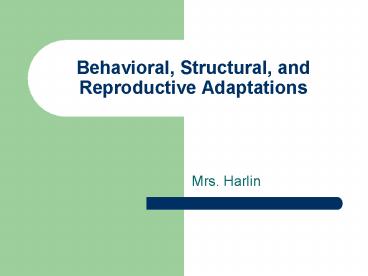Behavioral, Structural, and Reproductive Adaptations - PowerPoint PPT Presentation
1 / 41
Title:
Behavioral, Structural, and Reproductive Adaptations
Description:
Behavioral, Structural, and Reproductive Adaptations Mrs. Harlin 2.1.2 Analyze the survival and reproductive success of organisms in terms of behavioral, structural ... – PowerPoint PPT presentation
Number of Views:486
Avg rating:3.0/5.0
Title: Behavioral, Structural, and Reproductive Adaptations
1
Behavioral, Structural, and Reproductive
Adaptations
- Mrs. Harlin
2
2.1.2
- Analyze the survival and reproductive success of
organisms in terms of behavioral, structural, and
reproductive adaptations.
3
Circulatory System
- http//videos.howstuffworks.com/science-channel/29
103-100-greatest-discoveries-blood-flow-theory-vid
eo.htm
4
Transport and Excretion
- Animals
- Food absorbed from the digestive system enters
the circulatory system where nutrients are
delivered to cells throughout the body.
5
Digestive System
- Enzymes break down food into smaller components.
- Mouth (carbohydrates)
- Esophagus
- Stomach (proteins)
- Small Intestines (carbohydrates, proteins,
lipids, and nucleic acids) - Large Intestines (absorbs water)
- Anus
6
Liver
- Removes excess glucose and stores it as glycogen.
- Converts amino acids and fats into energy to be
used during metabolism. - Stores vitamins and minerals.
- Produces bile for fat digestion.
7
(No Transcript)
8
Homeostasis
- Drinking to much during meals or not eating a
well balanced diet can alter the acidity of the
stomach, making digestion harder. - Not drinking enough water throughout the day can
also decrease digestion because without water
nutrients and waste cannot flow in and out of
cells.
9
pH Levels of Organs and Body Fluids Organ or
fluid pH level
- Saliva 6.5 to 7 (slightly acidic to neutral)
- Blood 7.36 (slightly alkaline)
- Stomach 1.5 to 3 (very acidic)
- Pancreatic juice 8.8 (alkaline)
- Bile 7 to 7.7 (slightly alkaline)
- Small intestine 7 to 7.5 (slightly alkaline)
- Large intestine 6.5 to 7.3 (slightly acidic to
slightly alkaline) - Urine 6.5 to 7 (slightly acidic to neutral)
10
Transport and Excretion
- Plants
- Vascular- water travels through tissues called
xylem sugar travels through tissues called
phloem. - Nonvascular- water and minerals enters directly
through the plasma membrane and travels through
the plant via osmosis.
11
Respiration
- Release of gases
- Cellular Respiration
- Aerobic- requires oxygen (animals, plants)
- Anaerobic- no oxygen required (yeast, bacteria)
12
Aerobic Respiration
- Animals
- Lungs (mammals, reptiles, birds, amphibians)
- Diffusion through the skin (amphibians, worms)
- Gills (fish and sharks)
13
Lungfish
- http//videos.howstuffworks.com/science/gills-vide
os-playlist.htmvideo-28395
14
Respiration
- Plants
15
Photosynthesis Respiration
Occurs in the presence of light (and chlorophyll in plant cells) Occurs at all times in cells
Requires energy (light) to make sugar (glucose) Releases energy from sugar
Complex substances (sugar) are formed from simpler ones. Complex substances (sugar) are broken down into simpler ones.
Carbon dioxide and water are the raw materials. Carbon dioxide and water are the waste products.
Oxygen is given out. Oxygen is taken in.
16
Aerobic Cellular Respiration
- Occurs in the mitochondria of animal and plant
cells! - O2 glucose -gt CO2 H2O ATP
17
Anaerobic Respiration
- Alcoholic fermentation occurs in yeast and some
bacteria, and produces carbon dioxide and ethyl
alcohol. - Lactic Acid fermentation occurs in muscle cells
and bacteria. A build up of lactic acid is what
causes muscle soreness.
18
Nutrition
- Autotrophs- organisms that can make their own
food (photosynthesis). - Heterotrophs- organisms that consume food or
decompose food.
19
Photosynthesis
- Occurs in chloroplasts of plants and some
protists such as algae. - CO2 H2O -gt O2 glucose
- Sunlight is the energy source.
20
Reproduction
- Sexual- gametes are needed to create offspring
with variation. - Asexual- gametes are not needed because an
organism makes an exact copy of itself.
21
Sexual Reproduction
- Animals- egg and sperm make a zygote, which grows
into an embryo, which grows into a fetus - Plants- egg and pollen make a seed which
germinates. - Plants and Fungi- some make spores
22
Internal Fertilization
- Egg and sperm unite inside the organism.
- Mammals- nourishment by the placenta
- Birds
- Reptiles
Nourishment by amniotic egg
23
External Fertilization
- Egg and Sperm unite outside of the organism.
- Amphibians
- Fish
- Ferns
- Water is needed for fertilization.
24
Seed plants
- Gymnosperms- cone bearing plants
25
(No Transcript)
26
Seed plants
- Angiosperms- flowering plants
27
(No Transcript)
28
(No Transcript)
29
Behavioral Adaptations
- As an organism develops special behaviors which
may be innate or learned are important for
survival.
30
Suckling
31
Taxis
- Chemotaxis (Termites release pheromones for
communication) - Phototaxis (Plants response to light)
32
Migration
33
Estivation/Hibernation
- A state of lower metabolic activity- torpor.
- Estivation- summer heat and drought
- Hibernation- winter cold and drought
34
Habituation
- Habituation is when an organism stops responding
to a stimulus after repeated exposure.
35
Imprinting
- Imprinting is learning that occurs early in
development that cannot be changed such as ducks
and geese recognizing the first person they see
as their mother.
36
Classical Conditioning
- Stimulus association
- Ex Pavlovs dogs
- Belldog salivating because he associates it
with food.
37
Trial and Error Learning
- Rewards and punishments
38
Basking Shark
- http//www.arkive.org/basking-shark/cetorhinus-max
imus/video-06.html
39
Red-Breasted Goose
- http//www.arkive.org/red-breasted-goose/branta-ru
ficollis/video-09b.html
40
References
- tutorvista.com
- lauragrady.com
- writeonnevada.com
- http//www.cliffsnotes.com/study_guide/Vascular-Pl
ants-Described.topicArticleId-8741,articleId-8672.
html - http//sharonapbio-taxonomy.wikispaces.com/Plants-
Gymnosperms - http//www.ucadia.com/uca/u13/133200.htm
- kingdomplantae.blogspot.com
- childrenscolorado.org
- reptilegardens.com
- myths.e2bn.org
- Arkive.org
- http//sbi3u1tdoust.edublogs.org/2010/06/01/respir
ation/ - vtaide.com
41
References
- shs.westport.k12.ct.us
- http//backyardnaturalist.ca/?page_id702
- Howstuffworks.com

